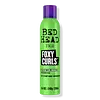What's inside
What's inside
 Benefits
Benefits

No benefits
 Concerns
Concerns

 Ingredients Side-by-side
Ingredients Side-by-side

Water
Skin ConditioningIsobutane
Acrylates/Hydroxyesters Acrylates Copolymer
Glycerin
HumectantPropane
Phenoxyethanol
PreservativeAminomethyl Propanol
BufferingPPG-5-Ceteth-20
EmulsifyingCaprylyl Glycol
EmollientPEG-12 Dimethicone
Skin ConditioningVp/Acrylates/Lauryl Methacrylate Copolymer
Parfum
MaskingPolysorbate 20
EmulsifyingMyristamidopropyl Pg-Dimonium Chloride Phosphate
Skin ConditioningTetrasodium EDTA
Butane
Benzophenone-4
UV AbsorberWater, Isobutane, Acrylates/Hydroxyesters Acrylates Copolymer, Glycerin, Propane, Phenoxyethanol, Aminomethyl Propanol, PPG-5-Ceteth-20, Caprylyl Glycol, PEG-12 Dimethicone, Vp/Acrylates/Lauryl Methacrylate Copolymer, Parfum, Polysorbate 20, Myristamidopropyl Pg-Dimonium Chloride Phosphate, Tetrasodium EDTA, Butane, Benzophenone-4
Water
Skin ConditioningIsobutane
Vp/Methacrylamide/Vinyl Imidazole Copolymer
Propane
Polyquaternium-46
Steareth-21
CleansingPhenoxyethanol
PreservativePolysorbate 20
EmulsifyingEthyltrimonium Chloride Methacrylate/Hydrolyzed Wheat Protein Copolymer
Parfum
MaskingTapioca Starch
PEG/PPG-17/18 Dimethicone
EmulsifyingPEG-12 Dimethicone
Skin ConditioningPentaerythrityl Tetracaprylate/Tetracaprate
EmollientCaprylyl Glycol
EmollientPolymethylsilsesquioxane
Linalool
PerfumingWater, Isobutane, Vp/Methacrylamide/Vinyl Imidazole Copolymer, Propane, Polyquaternium-46, Steareth-21, Phenoxyethanol, Polysorbate 20, Ethyltrimonium Chloride Methacrylate/Hydrolyzed Wheat Protein Copolymer, Parfum, Tapioca Starch, PEG/PPG-17/18 Dimethicone, PEG-12 Dimethicone, Pentaerythrityl Tetracaprylate/Tetracaprate, Caprylyl Glycol, Polymethylsilsesquioxane, Linalool
Ingredients Explained
These ingredients are found in both products.
Ingredients higher up in an ingredient list are typically present in a larger amount.
Caprylyl Glycol is a humectant and emollient, meaning it attracts and preserves moisture.
It is a common ingredient in many products, especially those designed to hydrate skin. The primary benefits are retaining moisture, skin softening, and promoting a healthy skin barrier.
Though Caprylyl Glycol is an alcohol derived from fatty acids, it is not the kind that can dry out skin.
This ingredient is also used as a preservative to extend the life of products. It has slight antimicrobial properties.
Learn more about Caprylyl GlycolWe don't have a description for Isobutane yet.
Parfum is a catch-all term for an ingredient or more that is used to give a scent to products.
Also called "fragrance", this ingredient can be a blend of hundreds of chemicals or plant oils. This means every product with "fragrance" or "parfum" in the ingredients list is a different mixture.
For instance, Habanolide is a proprietary trade name for a specific aroma chemical. When used as a fragrance ingredient in cosmetics, most aroma chemicals fall under the broad labeling category of “FRAGRANCE” or “PARFUM” according to EU and US regulations.
The term 'parfum' or 'fragrance' is not regulated in many countries. In many cases, it is up to the brand to define this term.
For instance, many brands choose to label themselves as "fragrance-free" because they are not using synthetic fragrances. However, their products may still contain ingredients such as essential oils that are considered a fragrance by INCI standards.
One example is Calendula flower extract. Calendula is an essential oil that still imparts a scent or 'fragrance'.
Depending on the blend, the ingredients in the mixture can cause allergies and sensitivities on the skin. Some ingredients that are known EU allergens include linalool and citronellol.
Parfum can also be used to mask or cover an unpleasant scent.
The bottom line is: not all fragrances/parfum/ingredients are created equally. If you are worried about fragrances, we recommend taking a closer look at an ingredient. And of course, we always recommend speaking with a professional.
Learn more about ParfumPEG-12 Dimethicone is a type of water-soluble silicone. It has skin conditioning and hydrating properties.
According to a manufacturer, this ingredient's stability is decreased by strong acid or alkali.
Phenoxyethanol is a preservative that has germicide, antimicrobial, and aromatic properties. Studies show that phenoxyethanol can prevent microbial growth. By itself, it has a scent that is similar to that of a rose.
It's often used in formulations along with Caprylyl Glycol to preserve the shelf life of products.
Polysorbate 20 is made by combining ethoxylation of sorbitan, ethylene oxide, and lauric acid. It is a mild cleansing agent, surfactant, and emulsifier.
As a surfactant, it helps collect dirt and oils for washing. Emulsifiers prevent oils and water from separating.
Polysorbate 20 also adds scent to a product. Since it is made using sorbitol, it has a sweet scent. Sorbitol can also be found in fruits such as apples and peaches.
The lauric acid used to create Polysorbate 20 is often derived from coconuts.
Polysorbate 20 may not be fungal acne safe.
Learn more about Polysorbate 20Propane is a gas derived from petroleum and natural gas. It is used as a propellant.
This ingredient is most commonly used in shaving cream, hair products, and makeup.
Water. It's the most common cosmetic ingredient of all. You'll usually see it at the top of ingredient lists, meaning that it makes up the largest part of the product.
So why is it so popular? Water most often acts as a solvent - this means that it helps dissolve other ingredients into the formulation.
You'll also recognize water as that liquid we all need to stay alive. If you see this, drink a glass of water. Stay hydrated!
Learn more about Water